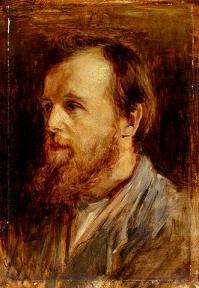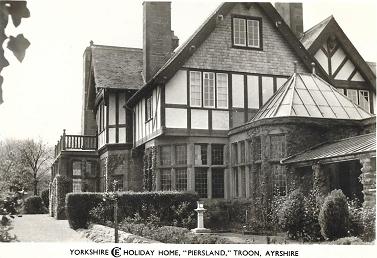Tree
Contact
Index
Bing Maps
|
21st May 1839 - 27th May 1916
|

Portrait of William Leiper
by Colin Hunter (1869)
|
According to Internet sources as yet unconfirmed, William Leiper was born on 21st May 1839 and
christened before the Associate Session, Glasgow, on 23rd June.
William Leiper officiated as a witness at the marriage of Colin Hunter and Isabella Rattray Young on 20th
November 1873. Since the other witness was the bride’s sister, it might readily be surmised that William was the
best man and as such a close friend of the groom. Both held connections to Helensburgh.
William Leiper might plausibly be identified with the ‘W.L.’ referred to in the pedigree authored by
George Stuart. According to this source, a gold ring inscribed around with
the name of its original owner, Henry or Harry Gordon, a captain in the Marines, descended to George’s brother,
the Rev. Harry Stuart, and thereafter to ‘W.L.’
Extracts from correspondence 1850-98, various
William Leiper (RSA), an architect, single, died on 27th May 1916, at 1h 50m pm at
Terpersie, Helensburgh. He was 77 years of age. The causes of death were certified by J. Ewing Hunter MB & CM
as cardiac haemorrhage and cardiac failure.
The informant, on 29th May 1916, was S. Sutherland, nurse, of 16/18 Sardinia Terrace (now Cecil Street),
Glasgow, present.
An excellent synopsis of William Leiper’s extraordinary professional career and enduring legacy, as documented by Ewan
Kennedy’s pioneering researches, is to be found on
Helensburgh Heritage.
|

Piersland Lodge, Sir Alexander Walker’s private residence in Troon, Ayrshire,
built in 1899, was designed by William Leiper. It is now the Piersland House Hotel.
William Leiper is known to have been actively involved in tracing his ancestral roots through the Terpersie dynasty,
an example of which is his copy, dated March 1893, of an already then ancient document under the title of
The Terpersie Family.
A note on Glasgow Art Club headed notepaper, concerning
John Leper, Burgess in Edinburgh, 1189, was probably also addressed to
him, apparently by Sheriff John Dean Leslie.
He kept up a lively correspondence over at least a quarter of a century and the following are examples of letters
which were written to him:
James Garden to William Leiper, 09 February 1877
James Garden to William Leiper, 14 February 1877
Margaret Garden to William Leiper, 19 February 1877
Margaret Garden to William Leiper, undated
Margaret Garden to William Leiper, 10 May 1877
James Macdonald to William Leiper, 18 December 1889
James Macdonald to William Leiper, 28 March 1890
James Macdonald to William Leiper, 04 August 1894
Sheriff John Dean Leslie to William Leiper, 03 July 1894
James McC. Pithie to William Leiper, 06 October 1898
Robert Stuart to William Leiper, 14 September 1903
William Clarke Leeper to William Leiper, 11 March 1909
William Clarke Leeper to William Leiper, 19 March 1909
He also engaged in an extensive correspondence with Captain Douglas Wimberley in 1893 and again from 1898-99, of
which the following twenty letters received by him have been preserved:
01 March 1893
05 March 1893
10 March 1893
16 March 1893
26 March 1893
04 April 1893
08 April 1893
17 April 1893
09 May 1893
31 August 1898
21 September 1898
19 October 1898
16 November 1898
13 June 1899
02 July 1899
12 July 1899
14 July 1899
12 September 1899
27 October 1899
09 November 1899
|
Trust Disposition and Settlement, 14th March 1913
|
William Leiper’s Trust Disposition and Settlement, dated 14th March 1913, was written by William Wyllie,
Clerk to R. and J. M. Hill Brown and Company, Writers, Glasgow. It made various provisions for the administration
and destination of his estate following his death and nominated four Trustees who were to act as executors, as
follows:
|
William Renwick, residing at Langgarth Stirling, James Whitelaw Hamilton, A.R.S.A, Artist residing in Helensburgh,
William McNab (otherwise William Hunter McNab) Architect in Glasgow, and Allan McLean, Writer, forty one West George
Street, Glasgow
|
There were a number of specific legacies. He left the portrait of his mother by William McTaggart R.S.A. to the
National Gallery of Scotland. To the said William McNab, he bequeathed:
|
the whole of the drawings belonging to me which are at present on loan to him in terms of an Agreement between
myself and him dated the twenty seventh day of October Nineteen hundred and nine the furniture, bric-a-brac, and
works of art which are also the subject of said Agreement being excluded from said bequest
|
He also provided for financial legacies, payable on the expiration of six months after his decease free of
Government duty, to the value of five hundred pounds, to each of the following beneficiaries: ‘Catherine McGregor my housekeeper’;
‘the said William McNab’ and William Leiper McNab, son of William McNab, to be payable to his father on his behalf,
in the event of William Leiper McNab still being in minority at the time when the payment fell due.
He also identified the residuary beneficiaries, ‘equal shares among the children alive at my decease of my cousin
Mrs Dunn and Henry James Stuart
Brown son of Peter Stuart Brown of the Acme Tea Chest Company Glasgow’. It
seems rather strange that Mrs Dunn’s Christian name, which was left blank, could not be specified, but she was
rather more effectively identified as ‘Mrs Isabella Gordon or Dunn’ in the Codicil dated 23rd July 1915.
The witnesses were the said William Wyllie, the same clerk who had written the document, and Alice Walker Lumsden,
nurse (presumably Mr Leiper’s), of 8, Lynedoch Place, Glasgow.
Somewhat remarkably, the testator appears to have had a sudden afterthought, as the first of two Codicils bore
the very same date as the Trust Disposition and Settlement. William Wyllie again composed the deed and the
witnesses were as previously.
The legacy in favour of ‘Catherine McGregor my housekeeper’ was increased from five hundred to seven hundred and
fifty pounds, free of legacy duty and payable at the testator’s decease. All the other legacies were to be payable
at the expiry of six months from that date. It was also provided:
|
I also direct my Trustees to make payment of a legacy of Two hundred and fifty pounds to her sister whom I have been
assisting (such sister being unmarried) and that free of legacy duty; in the event of her predeceasing me, her
legacy to be added to that directed to be paid to her sister Catherine
|
The second and final Codicil, dated 23rd July 1915, clarified the housekeeper’s full name as Catherine Fletcher
McGregor, and supplied her sister’s name, Jessie McGregor.
An ‘Oil painted portrait by Thomas Couture (French Artist)’ was bequeathed to the Trustees for the National Gallery
of Scotland and the sum of one thousand pounds was left to the Royal Scottish Academy.
The Codicil of 23rd July 1915 effected further fundamental amendments and designated the testator in the
following terms:
|
I, William Leiper, R.S.A. Justice of the Peace Architect residing at Terpersie, Helensburgh
|
The aforementioned ‘Henry James Stuart Brown, residing at Auchengrange Lochwinnoch’ was nominated and appointed to
be a Trustee and Executor. At the same time, his previous status as a residuary beneficiary was revoked.
The legacy in favour of the Royal Scottish Academy was reduced from one thousand to five hunded pounds.
At least a part of the reason for these deductions appears to have been the need to make adequate provision for the
children of his aforementioned cousin, ‘Mrs Isabella Gordon or Dunn’, who had died in the intervening period. The
Trustees were directed to divide the residue equally amongst those of Mrs Dunn’s children alive at the time of her
death ‘and the issue per stirpes alive at my decease of any deceasing children of my said deceased Cousin’.
The witnesses on this occasion were
|
James Torrance, Artist residing at The Glen Helensburgh and William White, retired Bank Agent residing at The
Turret, Helensburgh
|
William Leiper’s parents were William Leiper and
Jane Mellis.
William Leiper’s paternal grandparents were William Leiper and Jane Leiper MS Mitchell.
William Leiper’s maternal grandparents were William Mellis and Isobel Cattanach, sister of
Charlotte Boyd Cattanach, thus establishing that he was a second cousin of
Peter Stuart Brown.
William Leiper had two sisters. According to Internet sources as yet unconfirmed, Isobel was born on 3rd
July 1837 and christened 6th August, before the Associate Session, Glasgow. Jane was born 7th
January 1842 and christened 20th February, also before the Associate Session, Glasgow.
Bulloch, at p. 351, supplies Isobel’s middle name as Cattanach, thus establishing that she was named after her
maternal grandmother. Jane, as the second daughter, was named after her paternal grandmother, Jane Leiper MS
Mitchell.
At the time of the 1841 census, Isobel was entered as aged four and living in the family home in Row, Dunbartonshire.
At the time of the 1851 census, Isobel was aged 13. Jane was aged nine. Both were living in the family home in
Govan.

